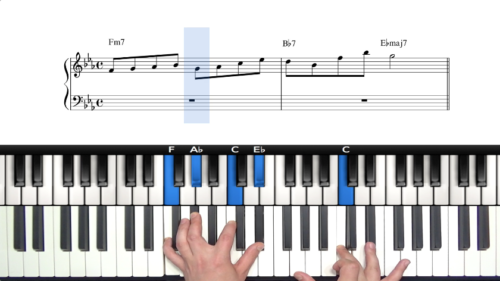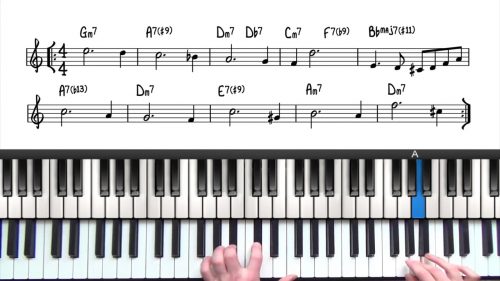The Extended Major 251 – 9ths & 13ths
So far in this practice series, we have looked at extensions over major, minor, & dominant chords, now it’s time to put them all together in the most common progression in jazz music – the 251 progression.
Building Upon 3 Note Voicings
In the Foundations course, we drilled through the 3 note voicings. Now we’re going to take this a step further and add the 9th to our ii-7 chord.
For D-7, we would have the root in our left hand, and then the b3, b7, and 9 in our right hand. I’d recommend this fingering because it gives you the option to add in the 5th later if you desire.
The Exact Same Movement – b7s dropping to 3rds
The movement is exactly the same between the 2 and 5, as it was with the 3 note voicings, but now we have the added richness of the 9 and 13 which you that beautiful jazzy texture.
Finally, to get the 1 chord, the b7 of G7 drops down by half a step in the same way as the 3 note voicings, and the top note falls by a full step to hit the 9th of Cmaj7.
We’re going to take that around all 12 keys, and remember to always analyse that top note in relation to the underlying chord. This is a nice drill because the extension is always right on the top of the voicing so it is easy to visualise.
Variations Of The Drill
The first variation is to add in the 5th of the ii-7 chord, without moving it, this then becomes the 9th of the V7 chord. Again all that’s changing is the 1 note falling from the b7 to the major 3rd of the next course.
Take this around all 12 keys and this will prepare you well for the next course on Rootless Voicings.
Closed Position Right-Hand Voicings
The next variation is to now start with the closed position voicing in our right hand. For this one, I’d recommend that you include the 5th. If we play it without the 5th, you can hear that the voicings are a little crunchy at the top, whereas, we add the 5th and it’s much more balanced.
It follows the same principle as the last example, it’s just that b7th dropping to the 3rds, and the other notes stay the same but change in relation to the underlying harmony.
Be Realistic With Yourself & Your Progress
Learning this in all 12 keys will take you months, perhaps even years to have it second nature, so you don’t need to think. Don’t be put off by this because we can work on other areas of your and just revisit these important drills from time to time.
Lesson Downloads
-
Chord Extensions Practice Plan File Type: pdf
-
Whole Step Extended 251s Type A File Type: pdf
-
Whole Step Extended 251s Type B File Type: pdf
Practice Tips
-
It's important that you are consciously analyzing the scale degrees to identify the 9s and 13s.
-
If you cannot 'see' or 'visualise' the extensions on the keyboard, then drop back to the associated scale and count up to find the scale degree.
-
Remember that the 9 is the same note as the 2, the 11 is the same note as the 4, and the 13 is the same note as the 6.
-
Once you are comfortable with the first drill, then move onto the closed position voicings.
-
These voicings take time and patience to master in all 12 keys, so don't be disheartened by slow progress.








If its not too much to ask can you add the open and closed position in notation, in all 12 keys? So we can read it from the stave.
It would be great to have the notation or even a video of all 12 keys in the closed position just for sake of completeness.
Any chance?
Thanks!
Hi Marla,
Please excuse the tardiness of my reply here. I wasn’t notified of this comment.
Yes the notation of the progressions in Type A and Type B is available on this lesson page: pianogroove.com/jazz-piano-lessons/extended-251-progression-drill/
and I have just added it to this page too to avoid any confusion.
Talk soon, cheers,
Hayden